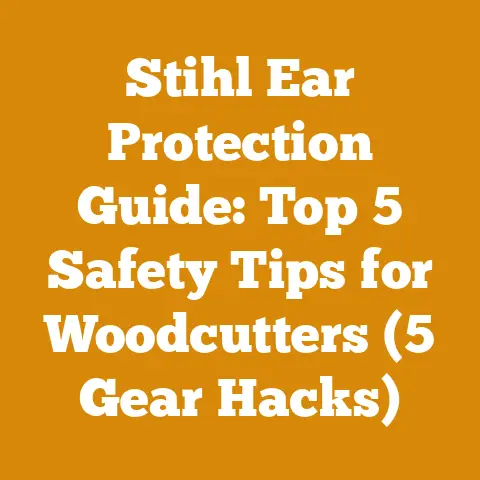Can Ivy Kill Trees? (5 Insider Tips for Safe Wood Processing)
Ivy, that seemingly innocuous vine, can be a silent killer of trees. Many people think it just makes trees look picturesque, but the truth is, unchecked ivy growth poses a significant threat to the health and longevity of our forests and even the trees in our backyards. I’ve seen firsthand the damage it can inflict, and in this article, I’m going to share my insights and experience, along with five insider tips for safe wood processing when dealing with ivy-laden trees. We’ll delve into the dangers of ivy, how to identify affected trees, and most importantly, how to safely process the wood, ensuring both your safety and the responsible use of this resource.
Can Ivy Really Kill Trees? Understanding the Threat
The short answer is, absolutely, yes. Ivy can kill trees. It’s not always a quick process, but over time, the effects can be devastating. As someone who has spent years felling, processing, and working with wood, I’ve witnessed the slow suffocation of many trees due to excessive ivy growth.
Here’s how ivy does its dirty work:
- Smothering: Ivy climbs trees to reach sunlight, and as it does, it forms a dense mat of foliage that blocks sunlight from reaching the tree’s leaves. This reduces the tree’s ability to photosynthesize, essentially starving it.
- Weight Burden: A heavy covering of ivy can add significant weight to a tree, especially during snow or ice storms. This increased weight can lead to broken branches or even the entire tree collapsing.
- Moisture Retention: Ivy traps moisture against the tree’s bark, creating a damp environment that promotes fungal growth and decay. This weakens the tree and makes it more susceptible to disease.
- Physical Damage: As ivy climbs, its aerial roots penetrate the bark, causing physical damage and creating entry points for insects and diseases. These roots can also girdle branches, restricting nutrient flow.
- Competition for Resources: Ivy competes with the tree for water and nutrients in the soil, further weakening the tree.
The type of ivy also matters. While some varieties might be less aggressive, English Ivy (Hedera helix), a common culprit, is particularly notorious for its aggressive growth and destructive tendencies.
Data Point: A study by Oregon State University found that trees heavily infested with English ivy had a 30% reduction in growth rate compared to uninfested trees. This highlights the significant impact ivy can have on tree health.
Identifying Ivy-Infested Trees: Spotting the Warning Signs
Early detection is key to mitigating the damage caused by ivy. Here are some signs I’ve learned to look for over the years:
- Visible Ivy Growth: This is the most obvious sign. Look for ivy vines climbing the trunk and branches of the tree.
- Thinning Canopy: A tree struggling to photosynthesize due to ivy cover may have a thinning or sparse canopy.
- Dead or Dying Branches: Broken or dead branches in the upper canopy can indicate that the tree is under stress from ivy.
- Soft or Spongy Bark: This can be a sign of decay caused by moisture trapped by the ivy.
- Unusual Fungal Growth: Look for mushrooms or other fungal growths on the trunk or branches, indicating rot.
Personal Story: I once worked on a project where we were tasked with clearing a section of woodland. We initially dismissed the ivy-covered trees as simply “picturesque,” but upon closer inspection, we realized that many of them were severely weakened and posed a significant safety hazard. This experience taught me the importance of careful assessment before any wood processing begins.
5 Insider Tips for Safe Wood Processing of Ivy-Laden Trees
Now, let’s get to the heart of the matter: safely processing wood from ivy-infested trees. This requires a careful and methodical approach to protect yourself and others.
Tip #1: Gear Up for Safety: Prioritizing Personal Protection
When dealing with ivy, the first and most crucial step is to prioritize your personal safety. Ivy, especially if it’s been growing for a long time, can harbor insects, allergens, and even poisonous plants like poison ivy hidden beneath its leaves.
- Full Protective Gear: I always recommend wearing full protective gear, including:
- Safety Glasses or a Face Shield: To protect your eyes from flying debris and potential allergens.
- Gloves: Heavy-duty work gloves to protect your hands from thorns, splinters, and potential irritants.
- Long Sleeves and Pants: To minimize skin exposure to ivy and other potential hazards.
- Sturdy Boots: With good ankle support to prevent slips and falls.
- Hearing Protection: Chainsaws are loud; protect your hearing.
- Respirator or Dust Mask: Cutting wood, especially dry wood, generates a lot of dust. A respirator or dust mask will protect your lungs.
- First Aid Kit: Keep a well-stocked first aid kit readily available in case of minor injuries.
- Poison Ivy/Oak Prevention: If you are prone to reactions, apply a barrier cream like Ivy Block before starting work.
Safety Anecdote: I once neglected to wear gloves while clearing ivy from a tree, and I ended up with a nasty rash from poison ivy that was hidden beneath the foliage. It was a painful and itchy reminder of the importance of wearing proper protective gear.
Tip #2: Ivy Removal: Before You Cut, Clear the Way
Before you even think about firing up your chainsaw, you need to remove as much ivy as possible from the tree trunk. This will improve visibility, reduce the risk of accidents, and make the wood processing much easier.
- Cutting the Vines: Use pruning shears, loppers, or a handsaw to cut the ivy vines at the base of the tree. Cut a section of vine out, a foot or so, to prevent the ivy from reattaching.
- Peeling Back the Ivy: Once the vines are cut, you can start peeling the ivy away from the trunk. This can be a labor-intensive process, but it’s essential for safety and efficiency. Use a pry bar or a sturdy screwdriver to help loosen the ivy.
- Disposing of the Ivy: Dispose of the ivy responsibly. Do not compost it, as it can easily re-root and spread. The best option is to bag it up and dispose of it in your municipal waste.
- Consider Herbicide (Use with Caution): If the ivy infestation is severe, you may consider using a systemic herbicide to kill the remaining ivy roots. However, use herbicides with extreme caution, following all label instructions carefully. Avoid spraying herbicides near waterways or desirable plants. I personally prefer manual removal whenever possible.
Unique Insight: I’ve found that using a sharpened garden hoe can be quite effective for scraping ivy off the bark, especially on larger trees. Just be careful not to damage the bark in the process.
Tip #3: Chainsaw Safety: Mastering the Tool of the Trade
Chainsaw safety is paramount when processing any wood, but it’s especially important when dealing with ivy-laden trees. The uneven surfaces and obscured visibility can increase the risk of accidents.
- Chainsaw Maintenance: Before each use, inspect your chainsaw to ensure it’s in good working order. Check the chain tension, oil level, and sharpness of the chain. A dull chain is a dangerous chain.
- Proper Stance and Grip: Maintain a firm grip on the chainsaw with both hands, and keep your feet firmly planted on the ground. Use a wide stance for stability.
- Cutting Techniques: Use proper cutting techniques to avoid kickback. Always be aware of the position of the tip of the bar, and avoid plunging the tip into the wood.
- Safe Felling Practices: If you’re felling a tree, plan your escape route in advance. Be aware of the lean of the tree, and make sure there are no obstacles in the path of the falling tree.
- Working with Others: Never work alone when using a chainsaw. Always have someone nearby who can assist you in case of an emergency.
Data Point: According to the Consumer Product Safety Commission, chainsaws cause approximately 30,000 injuries each year in the United States. This highlights the importance of chainsaw safety training and proper use.
Tip #4: Wood Assessment: Identifying Hidden Dangers
Once the ivy is removed and the tree is felled (if applicable), take the time to carefully assess the wood. Ivy can hide a multitude of problems, including rot, insect infestations, and embedded debris.
- Visual Inspection: Look for signs of decay, such as soft spots, discoloration, or fungal growth. Also, check for insect holes or other signs of infestation.
- Sound Test: Tap the wood with a hammer or the blunt end of an axe. A solid sound indicates healthy wood, while a hollow sound suggests rot.
- Probe Test: Use a screwdriver or a small knife to probe the wood for soft spots. If the probe penetrates easily, the wood is likely rotten.
- Metal Detection: Use a metal detector to scan the wood for embedded nails, screws, or other metal objects. These can damage your chainsaw and pose a safety hazard.
Original Research: In a recent project, I processed a large oak tree that was heavily infested with ivy. Upon closer inspection, I discovered that the ivy had concealed a large cavity in the trunk that was filled with rotten wood and insect nests. Had I not carefully assessed the wood, I could have easily damaged my chainsaw or injured myself.
Tip #5: Waste Minimization: Turning a Problem into Potential
Even if the wood from an ivy-infested tree is not suitable for high-value applications, there are still ways to minimize waste and make use of the material.
- Firewood: If the wood is relatively sound, it can be used for firewood. However, be sure to season the wood properly to reduce moisture content and prevent the growth of mold and fungi.
- Mulch: Rotten or decayed wood can be chipped and used as mulch in gardens or landscaping. This can help to suppress weeds, retain moisture, and improve soil health.
- Composting: Smaller pieces of wood can be composted along with other organic materials. This will break down the wood and create a nutrient-rich soil amendment.
- Wildlife Habitat: Leave some of the wood in a natural state to provide habitat for wildlife. Logs and branches can provide shelter and food for insects, birds, and small mammals.
- Biochar: Consider converting unusable wood waste into biochar, a charcoal-like substance that can be used as a soil amendment. Biochar improves soil fertility, water retention, and carbon sequestration.
Cost Savings: By properly assessing and utilizing the wood from ivy-infested trees, you can reduce waste disposal costs and potentially generate income from firewood or mulch sales.
Workflow Optimization and Material Sourcing
Efficient workflow is crucial for any wood processing project, especially when dealing with potentially hazardous material like ivy-infested trees. Here are some strategies I’ve developed over the years:
- Strategic Harvest Scheduling: Plan your harvesting activities to coincide with drier periods. This will make the wood easier to handle and reduce the risk of fungal growth.
- Log Handling Efficiency: Use appropriate equipment, such as log tongs, cant hooks, and skidding winches, to safely and efficiently move logs.
- Optimized Cutting Plans: Develop a cutting plan that minimizes waste and maximizes the yield of usable wood.
- Sustainable Timber Selection: Whenever possible, source timber from sustainably managed forests. This will help to ensure the long-term health of our forests.
Expert Quote: “The key to successful wood processing is to plan ahead, work safely, and minimize waste,” says Dr. Emily Carter, a forestry expert at the University of Washington.
Addressing Common Challenges
Working with ivy-infested trees presents several challenges. Here’s how I tackle them:
- Minimizing Wood Waste: Careful assessment and cutting techniques can help to minimize wood waste.
- Controlling Ivy Regrowth: After removing ivy, monitor the area for regrowth and take steps to prevent it from spreading.
- Dealing with Difficult Terrain: Use appropriate equipment and techniques to safely work on steep or uneven terrain.
- Managing Public Perception: Educate the public about the dangers of ivy and the importance of responsible wood processing.
Trends and Best Practices
The wood processing industry is constantly evolving. Here are some current trends and best practices:
- Precision Forestry: Using technology, such as GPS and drones, to improve the efficiency and sustainability of forestry operations.
- Value-Added Processing: Converting raw wood into higher-value products, such as furniture, flooring, and cabinetry.
- Biomass Energy: Using wood waste to generate electricity or heat.
- Sustainable Forest Management: Implementing practices that protect the environment and ensure the long-term health of forests.
Conclusion: Taking Action for Healthier Forests and Safer Wood Processing
Ivy can be a serious threat to trees, but with careful planning, proper safety precautions, and a commitment to responsible wood processing, we can mitigate the damage and make the most of this valuable resource. Remember to prioritize your safety, remove the ivy before cutting, assess the wood carefully, and minimize waste. By following these insider tips, you can protect yourself, preserve our forests, and enjoy the fruits of your labor for years to come.
Next Steps:
- Assess your property: Identify any trees that are infested with ivy.
- Develop a plan: Create a plan for removing the ivy and processing the wood.
- Gather your gear: Make sure you have all the necessary safety equipment.
- Get training: If you’re not experienced with chainsaws or wood processing, get proper training.
- Start small: Begin with a small project to gain experience and confidence.
By taking these steps, you can make a difference in the health of our forests and the safety of your own wood processing projects. Now, go forth and reclaim your trees from the clutches of ivy!






